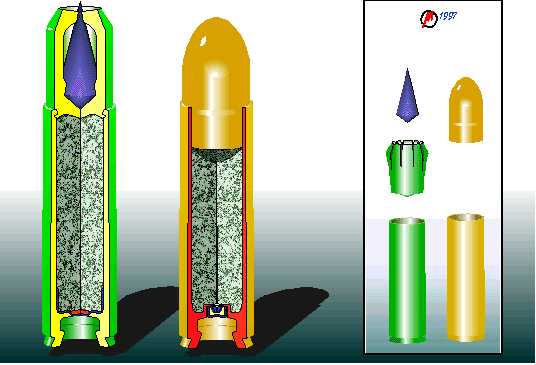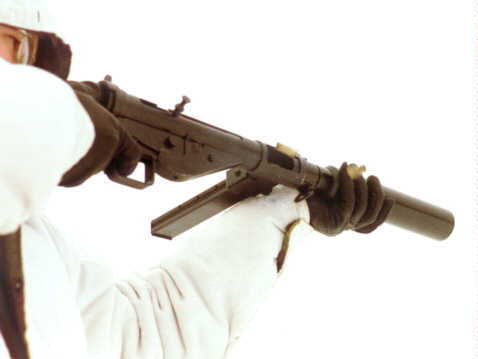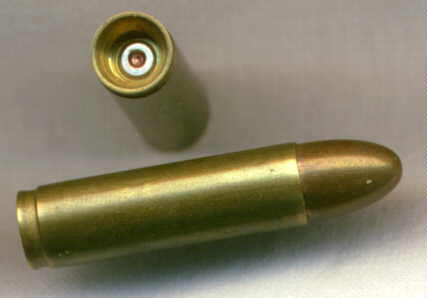Gunwriters' Front
Page Suomenkielinen Gunwriters
Link page
Original story written in Finnish 05.01.1991 by Juha Hartikka was published in
magazine "Urheiluampuja" in 1991. The story was translated in English
28.11.1997 by the writer. Updated 11. July, 1999. Used as a source for December 1999 Small Arms
Review (Vol 3 No 3) Page 25: A story based on "2030"
concept, written by Alan C. Paulson,
and to an article in Ronaldo Olive's
Brazilian Firepower magazine: "Cartridge 2030", Munição para 2030. See also Angelfire comments about
Gunwriters' saboted Cartridge 2030 concept and ideas about subsonic bullet.
Assault Rifle Cartridge M/2030
- The assault rifle cartridge of the next century? Well, I guess it must be the
caseless 4.73 x 33 mm round of the German Heckler & Koch Gewehr-11.
- If we look still further ahead in time, what might be the next step in ammo development?
- Nobody can tell that!
- Maybe nobody can tell for sure, but it can be predicted fairly well on ground of modern
technology. Would you believe, if I stated, that in about year 2030 an assault rifle
cartridge probably has a straight case and the projectile has a muzzle velocity of 1500 to
2000 meters per second. The bullet caliber is between 4 and 5 millimeters, while the bore
diameter is much larger, about 9 to 10 millimeters. The assault rifle can shoot both ultra
high speed 5 mm bullets, as well as slow 9 mm caliber class rounds - without changing
barrels! Besides, it is simpler and cheaper to produce than present assault rifles.
- You are confusing me! Those are opposite properties, that simply can not be combined! I
could believe the double muzzle speed as compared to the .223 NATO, but a five millimeter
round through a nine millimeter bore simply overdoes any common sense! And why any case at
all, if one can manage without?
- Can you tell me the disadvantages of traditional cased ammo in military use?
- Price and weight.
 - Right. But - the function of a case is not merely to carry the
powder. The case also seals the chamber of the rifle. A rifle designed to caseless ammo is
bound to be expensive and complex just because of sealing the pressurized chamber. A rifle
shooting cased ammo can be produced for a fraction of the price of a caseless rifle. As a
summary, it is more economical to use ammo with very lightweight and inexpensive case.
- Right. But - the function of a case is not merely to carry the
powder. The case also seals the chamber of the rifle. A rifle designed to caseless ammo is
bound to be expensive and complex just because of sealing the pressurized chamber. A rifle
shooting cased ammo can be produced for a fraction of the price of a caseless rifle. As a
summary, it is more economical to use ammo with very lightweight and inexpensive case.
- Sounds like daydreams. Please explain me such an impossibility!
- Please lend me that packet of cigarettes... thank you, I do not need matches, neither
these...
- There went my cigarettes by air... both of them...
- Then give me that pencil... watch the lines I am drawing... now, what is shaping on the
cover of the packet?
Cut-away drawing: Both the saboted (left) and full caliber
versions of the M/2030 cartridge are designed be shot from the same weapon. Caliber can
now be changed by changing cartridges only without any modifications to the weapon - which
may be of very simple and economic straight blowback type!
Countersunk Base Cartridge
- I might imagine it as some kind of a cartridge, but the base of it has sunk in, and it
has a hollow point bullet with a big spike sticking out of the hole in it's tip.
- It really has a novel type of base, which could be described as a countersunk base. The
bullet is a sub-caliber bullet, a principle already old and well known. The conical spike
in the middle is a hard alloy, ceramic or steel bullet sunk in a plastic accelerator or
sabot. The sabot is separated from the bullet by air drag immediately after the bullet
leaves the muzzle.
- Accelerator bullets really can reach incredible muzzle velocities, but isn't it's
accuracy rather poor?
- For the time, yes, but only with present-day rifles, which however have been made for
conventional full caliber bullets. On the other hand, artillery has used accurate
sub-caliber shells for decades, for example the Peenemunder Pfeilgeschoss (the Peenemunde
Arrow Projectile) in the 1940's. The modern ultra high speed fin stabilized sub-caliber
arrow shaped projectiles used in tank cannons are successors of the Pfeilgeschoss.
- What is the idea of that curious sunk base?
- The countersunk cartridge base makes possible to construct the rifle by the very simple
principle of straight blowback, which makes it possible to produce assault rifles for
ultra high velocity ammunition at the cost and ease comparable to fabricating STEN
sub-machine guns. As the cases are made of plastic, the cartridges are both lightweight
and inexpensive.
- Now you are fooling me! Even I know, that straight blowback can't be used for round more
powerful than the 9 mm Luger! And a plastic case simply can't stand the chamber pressure
of a rifle!
- During First World War Coenders brothers developed an anti aircraft automatic cannon. It
was called "Becker" by it's first manufacturer Stahlwerke Becker in
Reinickendorf, Germany, although later manufactured by Oerlikon in Switzerland. It
operated by straight blowback, and it's caliber was 20 millimeters. The cartridge case was
almost straight, and the striker hit the primer before the cartridge reached the end of
the chamber. "Floating fire" or "advanced ignition", you might call
it. The bolt head pushed the rebated cartridge base deep enough into the extra long
chamber. Right after firing the case slid backwards for a while before emerging from the
back of the extra long chamber. By this, the chamber pressure had already dropped to safe
level not to explode the ejected case. Moreover, recoil is not proportional to the bullet
speed or energy only. Also bullet mass a significant factor of the impulse you feel as a
kick against the shoulder. A lightweight sub-caliber bullet, which we are now drawing,
gives about as fierce a blow to the bolt end as a 9 mm Luger round. The countersunk base
does not fit in the bolt head, but the bolt head sinks in the base of the cartridge along
with the extractor. This way it is easy to seal the extra long chamber. And even this was
not all - ultra high speed does not necessarily mean ultra high chamber pressure. If we
compare a conventional bullet to a sub-caliber bullet of the same weight, but shot through
a bore of double diameter, we can see, that with sub-caliber bullets we can achieve about
four times the acceleration of full caliber bullets, without raising chamber pressure.
However, to make you comfortable, let's draw this metallic primer cup larger to serve also
as a base reinforcement. By the way, the primer is neither of Boxer or Berdan type - the
firing pin strikes and ignites the primer straight against the powder.
 The Swiss Oerlikon SSG36
anti-tank rifle demonstrated, that it was possible to build a succesfull straight blowback
rifle up to 20 mm caliber shooting at 750 m/s (2460 ft/s) velocity. The SSG36 used a
Becker principle of bolt head following the rebated cartridge base deep into the chamber.
After firing, the case and the bolt could safely back off from the chamber without
immediately exposing the base to explode under remaining chamber pressure. The bolt is
shown under the barrel with cartridge attached to the protruding bolt head.
The Swiss Oerlikon SSG36
anti-tank rifle demonstrated, that it was possible to build a succesfull straight blowback
rifle up to 20 mm caliber shooting at 750 m/s (2460 ft/s) velocity. The SSG36 used a
Becker principle of bolt head following the rebated cartridge base deep into the chamber.
After firing, the case and the bolt could safely back off from the chamber without
immediately exposing the base to explode under remaining chamber pressure. The bolt is
shown under the barrel with cartridge attached to the protruding bolt head.
 The cutaway drawing
of the blowback action Oerlikon SSG36 reveals the extra long chamber in which the
cartridge totally sinks along with the case head. The massive recoil of the 20 mm
cartridge was quite effectively tamed by the straight blowback operation and the mass of
the bolt creating much less vigorous kick than regular delayed blowback actions.
The cutaway drawing
of the blowback action Oerlikon SSG36 reveals the extra long chamber in which the
cartridge totally sinks along with the case head. The massive recoil of the 20 mm
cartridge was quite effectively tamed by the straight blowback operation and the mass of
the bolt creating much less vigorous kick than regular delayed blowback actions.
- Almost caught hold of the idea, but now you confused me again... How you can strike
anything against powder? And besides, a floppy plastic round is definitely crumpled when
feeding from the magazine.
- It strikes well against powder, if it is compressed powder. The powder is pressed to one
solid briquette, which snugly fills in and stiffens the plastic case. As an extra benefit,
the ignited primer first pushes the powder briquette forwards, which in turn detaches the
sabot and bullet uniformly and straight into the bore. This way the unstable bullet detach
is avoided, which is one of the inaccuracy causing factors of present small arms
sub-caliber rounds.
A Bullet, not a Compromise
- Shrewd, I would call that! The bullet seems to be of about half the diameter of the
bore, but why is it conical?
- The purpose of a sub-caliber bullet is merely to fly, not to seal the powder gas, nor
center itself into the bore or slide in the grooves of the rifling. The sabot seals,
slides, carries and guides the bullet through the bore, after which the sabot is discarded
from the bullet. So we are free to shape the bullet ideal to supersonic flight. This means
using smooth, straight surfaces. A drop shaped form is ideal for slow subsonic speeds, but
no more good after the sonic barrier is penetrated. At supersonic speeds a straight, sharp
cone as a bullet tip is best. The tail may be a shorter cone. This form was one of the
discoveries of wind tunnel tests executed during the supersonic Concorde passenger
aircraft project. If this double cone bullet leaves the muzzle at six times the velocity
of the sound, or Mach 6, it flies 300 to 500 meters in almost straight line. After that,
it has lost it's velocity down to subsonic speed, which causes it to destabilize, stumble
and drop almost suddenly. So, that means shooting from zero to half a kilometer with fixed
sights, plus a short danger zone behind the maximum shooting range.
One Weapon, Multiple Caliber
- And if I loaded the case with full caliber bullets, I could use the same rifle as a
sub-machine gun with slower and heavier bullets! PDW and OPW concepts combined!
- You grasped it. The assault rifle transforms to a sub-machine gun by only switching the
rounds, without having to change the barrel. The result is a true multipurpose rifle,
linking together Personal Defense Weapon and Objective Person Weapon concepts you quoted
to, and many other applications. Next, let's draft on this back cover a sunk base
cartridge with otherwise conventional brass case, bullet, powder and boxer primer. It
would be that easy to build a model of a sunk base sub-machine gun cartridge.

According to this photo, even the performance and construction
of an old 9 mm STEN SMG seem to be quite adequate for a test bench of sunk base
"2030" concept cartridges. As the cartridge is designed for straight blowback
action even at sub-caliber velocities exceeding 1500 m/s, the weapon firing them may be
fabricated at very modest expenses. Sten will fire sunk base cartridges with modifications
to barrel, bolt head and magazine assembly. This suppressed example appears to fire full
caliber brass case "2030" style cartridges. However, a specially reinforced
suppressor is capable of handling discarding sabot bullets, too.
Psychological Inertia
- But if all that were feasible, somebody would already have utilized it! Firearms
industry and armies would be fighting to get hold of it first! It would be much more
sensible to adopt a caliber satisfying armies' needs for a century, than upgrade and
replace all assault rifles after a couple of decades! And imagine the ease with ammo
logistics, if all handguns from rifles to sub-machine guns could use same cartridges!
- Bureaucratic decision-making and exploitation of technical innovations do not follow
common sense. Organizations operate more on nerves. A decision making process of a large
organization can be compared to a bottle cap: It's function is to hold the pressure, until
the consumer is ready to enjoy the contents.
- Why couldn't we uncork a new invention right away?
- We could, but not the majority of the users. There is a Theory about Speed
of Development, which claims, that societies exploit an innovation only
after the society has reached the stage of development of the innovation. It is a manner
of emptying bottles already opened, before uncorking a new bottle. The old .223 NATO
cartridge will continue it's triumphal march for years or decades, and the breakthrough of
H&K G-11 style cartridges is still years or decades ahead. Adopting a new line of
technology realized in small steps.
- But adopting a pocket calculator or a personal computer did not last for decades!
- The Theory about Speed of Development also claims, that an ancient line of technology is
exploited much slower than technologies born rather recently. A transistor was invented in
the 1940's, while firearms were built already in the 1200's, and weapons have been part of
societies from the dawn of humanity. Newly born electronics are almost free to develop,
while exploiting new weapons is controlled by some of the deepest age-old human feelings:
fears, prejudices, manners. These in turn control and brake the changing of societies with
laws and habits. This "speed limit" is an ingenious mechanism for a society to
survive: If the speed of development was not controlled any way, a large society would be
shuttered to fragments by the sudden changes that struck it.
- That sounds like fatalistic pessimism to me.
- To me it sounds like a simple law of nature. If I jerk that beer bottle over the table
edge, it follows the Law of Gravity down to a sudden stop, and according to Law of
Probability it is likely to go to pieces... OOPS, you really were quick!
 - I had to save it from the Laws of Nature before
you started to visualize them, because it was still half full! And that cartridge is
already so futuristic, that it must be impossible improve it any more!
- I had to save it from the Laws of Nature before
you started to visualize them, because it was still half full! And that cartridge is
already so futuristic, that it must be impossible improve it any more!
- Look here, I can tell you, that this cartridge can be further developed to as effective
and powerful as cognac is in comparison with wine! These principles I told you now are
based on present technology, but also the next really new steps in firearms technology to
come can already be predicted, like the amazing polymer powder. Would you like to hear
about the Assault Rifle Cartridge M/2060?
Photo at right: The full caliber 9 mm SMG cartridge version of the sunk base cartridge
(below) with a view to the structure of the base of an empty case (above). The shallow
groove around the base is only related to the manufacturing methods of the case, the real
extractor groove situated inside around the sleeves of the sunk base. The cartridge - bolt
composition in the firearm is reverse to conventional: The bolt head with the extractor
sinks into the cartridge base!
- Juha Hartikka -
Related links:
December 1999 Small Arms
Review (Vol 3 No 3) Page 25: A story based on "2030" concept,
written by Alan
C. Paulson.
Article in Ronaldo Olive's Brazilian Firepower
magazine: "Cartridge 2030", Munição para 2030.
SLAP
(Saboted Light Armor Penetrating) by Winchester-Olin. Sabots for reloaders. 12 GA Flechette sabots.
Angelfire comments about
Gunwriters' saboted Cartridge 2030 concept and ideas about subsonic bullet.